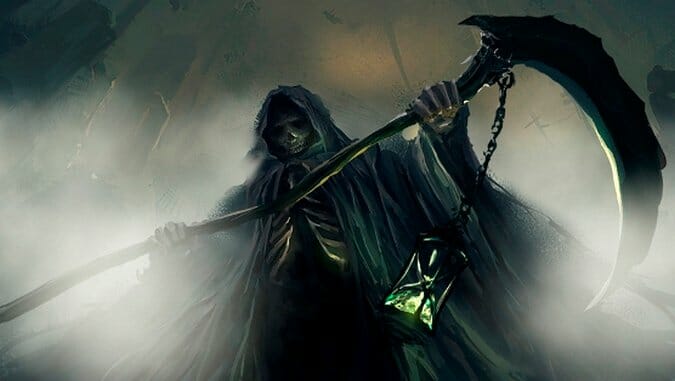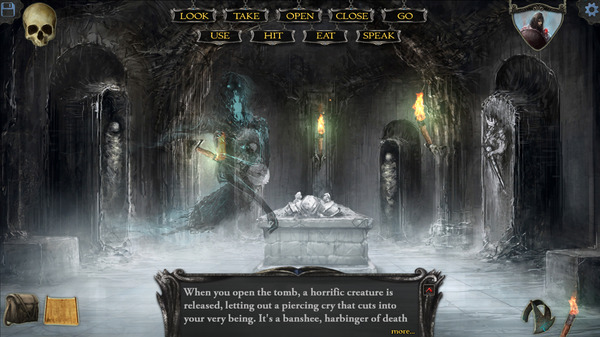
The original Shadowgate was released for the Mac in 1987 and was ported to a variety of systems including the NES. It terrified me as a kid. The cartridge sits on a shelf next to my NES, to this day unfinished. I have, though, read one of those videogame novelizations we call walkthroughs to the end. The walkthrough was easier to get through because it didn’t have the your-torch-is-about-to-go-out-and-you-are-about-to-die music or the room transition sound effect. (Zojoi’s Kickstarted remake has orchestrated versions of that eight-bit music, but includes “retro mode” options for music, transitions and text.)
I tell you this because I have no idea how this will play for someone not familiar with Shadowgate. Text that is an obvious reference to the difference between a room in this game and the original version might seem like a weak, non-sequitur cliche (mentioning how you’re at the “end of your rope” in a room that used to hold an enchantable rope but is now flooded.)
Anyway, back to those sounds. For adult-me, they still induce a feeling that I more commonly associate with an unprovoked anxiety attack: mild, targetless dread. Impending death.
This Shadowgate has the burning-out-torches and an early cursing that, at least in Master Mode, can lead to your death before you’ve had a chance to chase the MacGuffin down. It’s a Warlock Lord named…honestly, I can’t really remember. There are so many bizarre consonant-vowel combinations for all the dead characters whose books and scrolls you occasionally come across. Lore fleshes out the basic “dark lord wants power, you need to gain your OWN power to defeat him before he gets his power, yours is more legitimate power because an old dude with a beard told you to get it and also you are the Seed of Prophecy and you have proven your worth by solving these puzzles” puzzle-solving motivation.
Usually, these lore-sources don’t go over a few sentences and are occasionally important for solving puzzles, clues with varying degrees of subtlety: That “one readable passage” that is a list of names is clearly there for a reason and oh you just happen to have found a similar list elsewhere!
That’s being a bit glib; piecing together puzzles from hints in the game, a literal lateral thinking, and the occasional help from Yorick, the talking skull who cracks jokes and will give you hints if you ask for them (and, occasionally, if you’ve wandered around for a few hundred turns without doing anything, even if you haven’t) resulted in more than a few “aha!” moments. A few of them were slightly more colorful, as the solutions seemed so obvious in hindsight.
The different difficulty settings change the kind of hints Yorick gives, and how different puzzles are solved. An early example: The door on the first screen is framed with skulls. In Master difficulty, three of the skulls are missing. In Novice, only one is. There were times, I’ll admit, where I found myself trial-and-erroring my way to figure out what to do next. Because so many of the puzzles in this game involve items, even with Yorick and the lore you’re not ever quite sure you’ve got the right item that you need for a puzzle. Torches burn down and the curse progresses until cured on a turn-by-turn basis, so trial-and-error becomes a very risky proposition. Saving often is crucial, and I often employed a strategy of “save, try a whole mess of different things until you figure out the correct next step, then reload that save and move forward”. It turns save management into a part of the game, a built-in tool to assist speed runs.
Because the game is all pointing-and-clicking, there’s no punishment for slow reflexes. The only manual dexterity that’s required is being able to click an object on the screen. So if you don’t want to game the save system, a good memory or a set of notes means that you’re probably never ten or fifteen minutes worth of clicking to get back to where you were from the last auto-save after you die.
You will die a lot. Aside from the torches and the curse, death in Shadowgate is not a matter of attrition. No brutally graphic images that reward your emptying health bar with spectacle even as your time spent playing is taken from you. Walk into the wrong room without a shield equipped, try and TAKE the wrong item, stay too long in the wrong place and it’s a gruesome bit of text, a fade to the image of the grim reaper, and back to the menu screen.
These digitally painted screens use an Impressionist style, making it sometimes a bit difficult to tell what you can and can’t interact with. There’s no “hit a button and things will sparkle” hint option, but selecting objects causes them to pulse so usually after a few seconds on a screen you have a good idea of what can and can’t be touched.
I can’t be touched by Shadowgate in the way I was by the original. Twenty-five years have maybe left me a little less sensitive to on-screen dread. The elaborations of the art, the music, the atmosphere, they fill in some blanks that I didn’t even notice before.
This is a solid adventure, one that I gladly would have played even if I hadn’t any history with the original game. That history was both a help and a hindrance: It provided me with clues to some puzzle updates and red-herringed me (which I’m sure was the designers’ intent) on others. Maybe it primed me to be more forgiving of instant-death and borderline dark-fantasy nonsense. But I can’t say I’m disappointed.
Shadowgate was developed by Zojoi and published by Reverb Triple XP. It is available for the PC and Mac.
Brian Taylor is waiting for a Déjà Vu remake.
